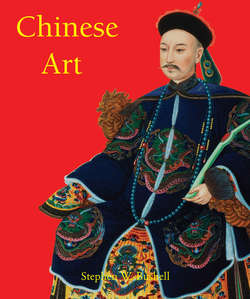Chinese Art

Реклама. ООО «ЛитРес», ИНН: 7719571260.
Оглавление
Stephen W. Bushell. Chinese Art
Historical Introduction
1. – Ancient Era
2. – Imperial Era
Qin Dynasty
Han Dynasty
Southern And Northern Dynasty
Tang Dynasty
Sung Dynasty
Yuan Dynasty
Ming Dynasty
Chronology
Qing Dynasty
I. Architecture
1. – Roof
2. – Military
3. – Civil
4. – Funereal
5. – Religious
II. Carving and Lapidary Arts
1. – Carving
A. – Wood
B. – Bamboo
C. – Ivory
D. – Bronze
2. – Lapidary Arts
A. – Jade
B. – Hard Stones
C. – Jewellery
III. Manufactured Materials
1. – Porcelain
Classification of Chinese Porcelain
a. – The Sung Dynasty (960–1279) and the Yuan Dynasty (1280–1367)
b. – The Ming Dynasty (1368–1643)
c. – K’ang Hsi Period, extending from the fall of the Ming Dynasty through the reign of K’ang Hsi (1644–1722)
d. – Yung Chêng and Ch’ien Lung Period (1723–1795)
2. – Enamels
3. – Lacquer
4. – Glass
5. – Snuff Bottles
6. – Dress
IV. Pictorial Art
1. – Primitive Period up to 264 A. D
2. – Classical Period and the Dunhuang Caves (265–960)
Caves of Dunhuang
3. – From Sung to Ming Dynasty (960–1368)
4. – Ming Dynasty (1368–1643)
5. – The Early Qing Dynasty (1644–1755)
Bibliography
Отрывок из книги
Anonymous, The Kangxi Emperor (1654–1722) A Tang poem about the lotus in bloom, c. 1703.
Hanging scroll, ink on silk, 186.7 × 85.3 cm.
.....
The next dynasty, the Han, was the first to open up regular communication with western countries by sending Chang Ch’ien on a mission to the Yueh-ti, or Indo-Scythes, whose capital was then on the northern bank of the Oxus River. The envoy started in 139 B. C., was kept prisoner for ten years by the Hiung-nu Turks, who ruled Eastern Turkestan, but at last reached his destination through Ta Yuan (Fergana). Travelling through Bactria, he tried to return by the Khotan Lobnor route, but was again stopped by the Hiung-nu, until he finally escaped and got back to China in 126 B. C., after an absence of thirteen years. Chang Ch’ien found bamboo staves, cloth, and other goods offered for sale in Bactria, which he recognised as products of Szechuan, and was told that they were brought there from Shên-tu (India). He reported to the emperor the existence of this southwestern trade between China and India, and also the name of Buddha and of Buddhism as an Indian religion. The grape vine (pu-t’ao), the lucerne (Medicago sativa), the pomegranate from Parthia (Anhsi), and several other plants were introduced into China by him, and were cultivated in the Shang Lin Park at the capital.
The Emperor Wu Ti subsequently sent friendly embassies to Sogdiana, and to Parthia in the beginning of the reign of Mithradates II., and sent an army to Fergana in 102–100 B. C., which conquered the Kingdom of Ta Yuan, and brought back in triumph thirty horses (of classical fame). In the far south, Kattigara (Indochina China) was annexed in 110 B. C., given the Chinese name of Jih Nan, “South of the Sun,” and a ship was dispatched from that port to get a supply of the coloured glass of Kabulistan, which was becoming so highly valued at the Chinese court.
.....